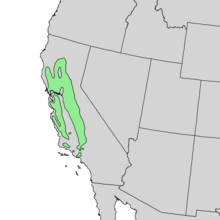Valley Oak
| Quercus lobata | |
|---|---|
 |
|
| Valley Oak near Mount Diablo, with Mistletoe. | |
| Scientific classification | |
| Kingdom: | Plantae |
| (unranked): | Angiosperms |
| (unranked): | Eudicots |
| (unranked): | Rosids |
| Order: | Fagales |
| Family: | Fagaceae |
| Genus: | Quercus |
| Section: | Quercus |
| Species: | Q. lobata |
| Binomial name | |
|
Quercus lobata Née 1801 |
|
 |
|
| Natural range of Quercus lobata | |
| Synonyms | |
|
List
|
|
Quercus lobata, commonly called the valley oak or roble, grows into the largest of North American oaks. It is endemic to California, growing in interior valleys and foothills from Siskiyou County to San Diego County. Mature specimens may attain an age of up to 600 years. This deciduous oak requires year-round access to groundwater.
Its thick, ridged bark is characteristic and resembles alligator hide. The valley oak's deeply lobed leaves assist in identification.
The sturdy trunk of the valley oak may exceed three meters (10 feet) in diameter and its stature may surpass 30 meters (100 feet) in height. The "Henley Oak", in Covelo, California, is the tallest known North American oak, at 153 feet (47 m).
The branches have an irregular, spreading and arching appearance that produce a profound leafless silhouette in the clear winter sky. During Autumn leaves turn a yellow to light orange color but become brown during mid to late fall. In advancing age the branches assume a drooping characteristic. Its pewter-colored rippled bark adds to the attractive aesthetic of this species.
Typically, leaves are five to ten centimeters (2-4 inches) long and are roundly and deeply lobed. The leaf width is approximately one half its length. Each leaf is matte green with an underneath pale green appearance; moreover, the leaf is covered with abundant soft fuzz, yielding an almost velvety feeling. When a fresh leaf is rubbed or broken, an aromatic scent is exuded, evoking a forest odor. The wood is a dull brown approaching yellow, and it has not been used extensively for milling.
Over most of the range, acorns fall in October. A variety of mammals and birds eat them, including the acorn woodpecker, California scrub jay, yellow-billed magpie, and California ground squirrel. The acorns are also attacked by bruchid beetles, but can survive moderate levels of infestation. Surviving acorns all germinate in their first winter, and none remain by mid-winter. The acorns are medium to dark brown and range from two to three centimeters (0.8-1.2 inches) in length. The caps have deep stippling and are found most often as singlets, but occasionally as doublets. The Concow tribe call the acorns lō-ē’ (Konkow language).
...
Wikipedia
